It’s a wonderful world — and universe — out there.
Come explore with us!

Science News Explores
Trip to mars could damage astronauts’ brains.
In mouse experiments, ‘space’ radiation caused memory, learning woes
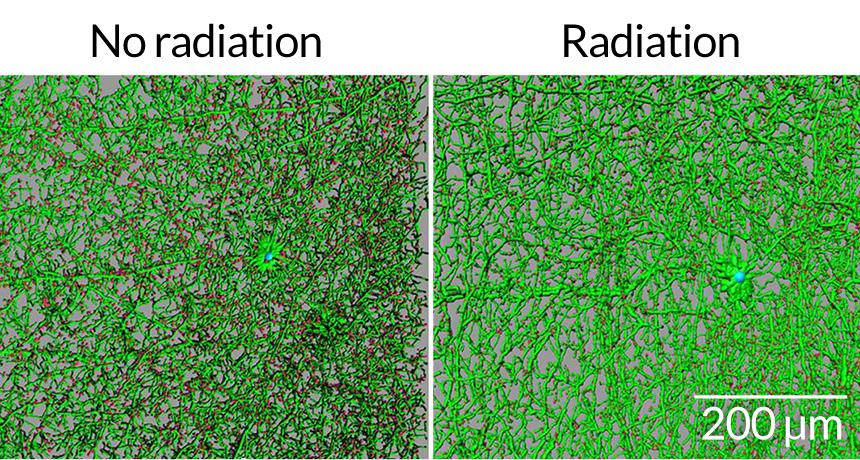
Mice data suggest that astronauts could suffer brain damage on the long trip to and from Mars. After being exposed to radiation, parts of nerve cells (green) in the brains of mice were shorter (right digital image) — and branched less — than in unexposed mice (left).
V. PARIHAR ET AL/SCIENCE ADVANCES 2015
Share this:
- Google Classroom
By Laura Sanders
May 10, 2015 at 6:00 am
Particles zipping through space could be the wrong stuff for Mars astronauts.
A study using mice found these high-energy particles slice through the brain. They pruned back connections linking brain cells. This left the animals with memory and learning problems. The study’s authors now worry that astronauts could suffer similar effects on long missions outside Earth’s protective atmosphere. One example: traveling to Mars.
The new findings are “worrisome, very worrisome,” says M. Kerry O’Banion. As a neuroscientist he studies how the brain works. O-Banion works at the University of Rochester Medical Center in New York.
The explosion of massive stars creates cosmic rays. This energetic radiation consists of electrically charged particles. Traveling through space at nearly the speed of light, theis radiation would bombard a spacecraft and its astronauts. For how long? Well, a human mission to Mars could last between one and three years, the National Aeronautics and Space Administration estimates.
Charles Limoli works at the University of California, Irvine. For his team’s new study, the scientists beamed mice with high-energy charged particles. The idea was to simulate cosmic rays in space.
Six weeks later, the mice showed memory problems. They had a harder time recognizing new toys than did unzapped mice. They also did a poorer job of remembering where a toy had been. Details appeared May 1 in Science Advances .
Visible brain damage also showed up. The radiation shortened the complex branches on nerve cells that receive messages. It also left these brain cells with fewer branches, the team found. “We weren’t expecting such dramatic effects from these charged particles,” says Limoli.
Translating the findings to people
These findings suggest Mars astronauts, too, might suffer brain problems. And such effects could emerge while they were still in space. “Over the course of a long-term mission, this may become very problematic,” Limoli says. It could affect how well people perform on missions, including how quickly and how well they make decisions. Brain impacts also might persist even after they got back home.
Translating these data to people, however, is difficult, O’Banion says. “There are big differences in the way the animals are exposed to the radiation versus how astronauts are,” he points out. Space also holds a more complex mixture of particles than those in the test beam. The doses differ too. So a lot remains unknown about how the human body and brain will respond to such radiation, he says.
Still, Limoli’s team observes, “Our data indicate an unexpected and unique susceptibility of the [brain] to space radiation.” And this argues that space radiation could impair the ability of astronauts to perform critical tasks, the scientists say.
NASA wants to send astronauts to Mars by the 2030s. Learning more about cosmic rays may help scientists create better ways to protect those astronauts. Adding shielding to a spacecraft is one solution. However, shielding adds weight. And that makes a spacecraft more expensive and more difficult to launch.
Power Words
(for more about power words, click here ).
astronaut People trained to travel into space for research and exploration.
atom The basic unit of a chemical element. Atoms are made up of a dense nucleus that contains positively charged protons and neutrally charged neutrons. The nucleus is orbited by a cloud of negatively charged electrons.
cognitive A term that relates to mental activities, such as thinking, learning, remembering and solving puzzles.
cosmic An adjective that refers to the cosmos — the universe and everything within it.
cosmic rays Very high-energy particles, mostly protons, that bombard Earth from all directions. These particles mostly originate outside our solar system. They are equivalent to the nucleus of an atom. They travel through space at high rates of speed (often close to the speed of light).
Mars The fourth planet from the sun, just one planet out from Earth. Like Earth, it has seasons and moisture. But its diameter is only about half as big as Earth’s.
National Aeronautics and Space Administration (NASA) Created in 1958, this U.S. agency has become a leader in space research and in stimulating public interest in space exploration. It was through NASA that the United States sent people into orbit and ultimately to the moon. It has also sent research craft to study planets and other celestial objects in our solar system.
neuroscience Science that deals with the structure or function of the brain and other parts of the nervous system. Researchers in this field are known as neuroscientists .
nucleus Plural is nuclei. (in physics) The central core of an atom, containing most of its mass.
particle A minute amount of something.
proton A subatomic particle that is one of the basic building blocks of the atoms that make up matter. Protons belong to the family of particles known as hadrons.
star Thebasic building block from which galaxies are made. Stars develop when gravity compacts clouds of gas. When they become dense enough to sustain nuclear-fusion reactions, stars will emit light and sometimes other forms of electromagnetic radiation. The sun is our closest star.
More Stories from Science News Explores on Brain

You’re too distracted. Here’s why that matters and what to do about it

Handwriting may boost brain connections that aid memory

Scientists Say: Confirmation Bias

The teen brain is especially vulnerable to the harms of cannabis

Music has the power to move us physically and emotionally. Here’s why
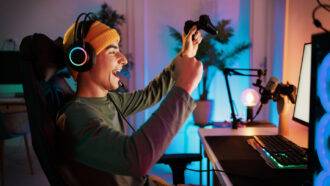
Let’s learn about the benefits of playing video games
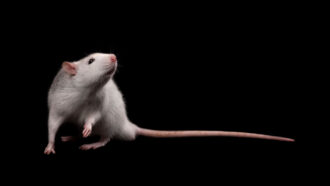
Like tiny Jedis, rats can move digital objects with their brains

Brain scans hint at how well teens will manage pandemic stress
New Research
A Trip to Mars Could Give You Brain Damage
Exposure to cosmic rays may cause defects that would make astronauts lose their curiosity during a mission
Adam Hoffman
/https://tf-cmsv2-smithsonianmag-media.s3.amazonaws.com/filer/0d/70/0d7033dc-41ca-404d-919e-4e0449688185/20040824_humans_on_mars_end-br2.jpg)
Space can be a dangerous place for fragile humans. Those willing to venture into Earth's orbit must negotiate health hazards such as extreme temperatures, cramped quarters, long periods of isolation and the debilitating physiological effects of life without gravity. Things will get even rougher for astronauts hoping to travel to an asteroid or Mars.
One of the greatest threats of deep-space travel is prolonged exposure to unrelenting cosmic radiation , which can damage DNA and increase a space traveler's chances of developing diseases such as cancer in their lifetime. Now, research in mice suggests that the first people to attempt a Mars mission will have a more immediate problem: brain damage. Cosmic rays bombarding the brain may result in cognitive and memory impairments that will manifest in just a few months.
Galactic cosmic radiation is made of high-energy particles originating from past supernova explosions that come zipping through our solar system. NASA has sponsored numerous studies investigating the short-term and long-term effects of space radiation on each system in the body, revealing that these rays can have a devastating effect on biological tissue over a lifetime.
Previous studies suggested that radiation exposure could also cause cognitive impairment , including earlier onset of Alzheimer's-like dementia. Now Charles Limoli , a professor of radiation oncology at the University of California Irvine School of Medicine, and his team have demonstrated that even relatively low doses of cosmic rays will induce a specific series of neural abnormalities that could manifest themselves during a round-trip mission to Mars, which is predicted to last for two to three years.
“This is the first study, in my opinion, that really ties a lot of loose ends together and provides a mechanism for what’s going on to cause cognitive dysfunction,” says Limoli, whose team reports the results today in Science Advances .
To study the “mind numbing” effects of radiation, the researchers examined several groups of six-month-old mice—the approximate average age of astronauts in mouse years. The team blasted the mice with low or high doses of energetic charged particles similar to those found in galactic cosmic radiation. These particles displace electrons in living tissue that then trigger free radical reactions, which cause changes in the cells and tissues of the body. Although free radical reactions occur within milliseconds, the cellular abnormalities they cause take form over months or even years, so the researchers waited six weeks before testing the irradiated mice to allow the cellular mischief to unfold.
The results showed that irradiated mice were significantly impaired in their ability to explore new objects placed in their environment, a task that draws upon a healthy learning and memory system. “The animals that were exposed lost curiosity. They lost their tendency to explore novelty,” says Limoli.
Specifically, the team discovered radiation-induced structural changes in the medial prefrontal cortex, a brain region responsible for higher-order processes known to be engaged during memory tasks . Neurons in these impaired areas showed a reduction in the complexity and density of structures called dendrites, which act as antennae for incoming cellular messages and are essential for the efficient exchange of information throughout the brain. The research team also discovered alterations in PSD-95, a protein that is important for neurotransmission and is also associated with learning and memory.
The cellular changes in the dendrites were directly related to cognitive performance—the mice with the largest structural alterations had the poorest performance results. And although these deficiencies took time to manifest, they appear to be permanent.
Limoli notes that, while the work was done in mice, the damage seen in their study looks a lot like defects seen in human brains suffering from neurodegenerative conditions like dementia. “Because these types of changes have also been found in a range of neurodegenerative conditions and occur over the course of aging, it provides a logical backdrop for what radiation does to the brains of both rodents and humans,” says Limoli.
It's likely no one has seen these types of defects in today's astronauts because people working on the International Space Station are “protected by the Earth’s magnetosphere, which deflects anything that has a charge,” says Limoli. And while the astronauts that traveled to the moon were not protected by Earth’s magnetic embrace , their relatively short trips would have limited exposure levels to a fraction of those that would be experienced on a mission to Mars.
While the results of this experiment were striking, other experts emphasize that there is still a lack of sufficient data to make definitive conclusions about the effects of radiation of people. “A lot of the information we have has been extrapolated from studies of catastrophic events in World War II," says Nathan Schwadron , associate professor of space plasma physics at the University of New Hampshire. "We just don’t have a lot of knowledge about what happens to biological systems when exposed to high levels of radiation for prolonged periods. I think that there is a potential risk here, but we really just don’t understand it yet.”
So what is to be done? NASA is currently investigating more advanced shielding technologies that could better protect astronauts on long-term missions into deep space. Engineers could also alter the shielding capabilities within certain regions of the ship, such as where astronauts sleep, or fit people with specialized helmets for space walks, says Limoli.
Schwadron, whose research is primarily focused on the development advanced shielding, says the energy from galactic cosmic radiation is so high that it interacts with the shielding materials in potentially problematic ways. “What happens is that high-energy radiation hits the shield and then produces a bath of secondary particles. Neutrons are probably the primary example of this.” These high-energy particles can then interact with the body, inducing free radical reactions and subsequent tissue damage.
Moving forward, Limoli and his team plan to design experiments that more accurately simulate human exposure to galactic cosmic rays and investigate alternative underlying mechanisms and cell types that could contribute to the proliferation of cognitive deficits. He is also investigating pharmacological interventions that could protect brain tissue from this radiation.
“We have some promising compounds that will probably help quite a bit,” says Limoli. “This is not a deal breaker—it is something that we need to understand and be aware of so we are not caught off guard.”
Get the latest Science stories in your inbox.
Adam Hoffman | | READ MORE
Adam Hoffman is a freelance science writer living in New York City.
UK Edition Change
- UK Politics
- News Videos
- Paris 2024 Olympics
- Rugby Union
- Sport Videos
- John Rentoul
- Mary Dejevsky
- Andrew Grice
- Sean O’Grady
- Photography
- Theatre & Dance
- Culture Videos
- Fitness & Wellbeing
- Food & Drink
- Health & Families
- Royal Family
- Electric Vehicles
- Car Insurance Deals
- Lifestyle Videos
- UK Hotel Reviews
- News & Advice
- Simon Calder
- Australia & New Zealand
- South America
- C. America & Caribbean
- Middle East
- Politics Explained
- News Analysis
- Today’s Edition
- Home & Garden
- Broadband deals
- Fashion & Beauty
- Travel & Outdoors
- Sports & Fitness
- Sustainable Living
- Climate Videos
- Solar Panels
- Behind The Headlines
- On The Ground
- Decomplicated
- You Ask The Questions
- Binge Watch
- Travel Smart
- Watch on your TV
- Crosswords & Puzzles
- Most Commented
- Newsletters
- Ask Me Anything
- Virtual Events
- Betting Sites
- Online Casinos
- Wine Offers
Thank you for registering
Please refresh the page or navigate to another page on the site to be automatically logged in Please refresh your browser to be logged in
Space missions are damaging astronauts’ brains, study finds
Findings come amid surge in private space tourism, as well as potential missions to mars, article bookmarked.
Find your bookmarks in your Independent Premium section, under my profile
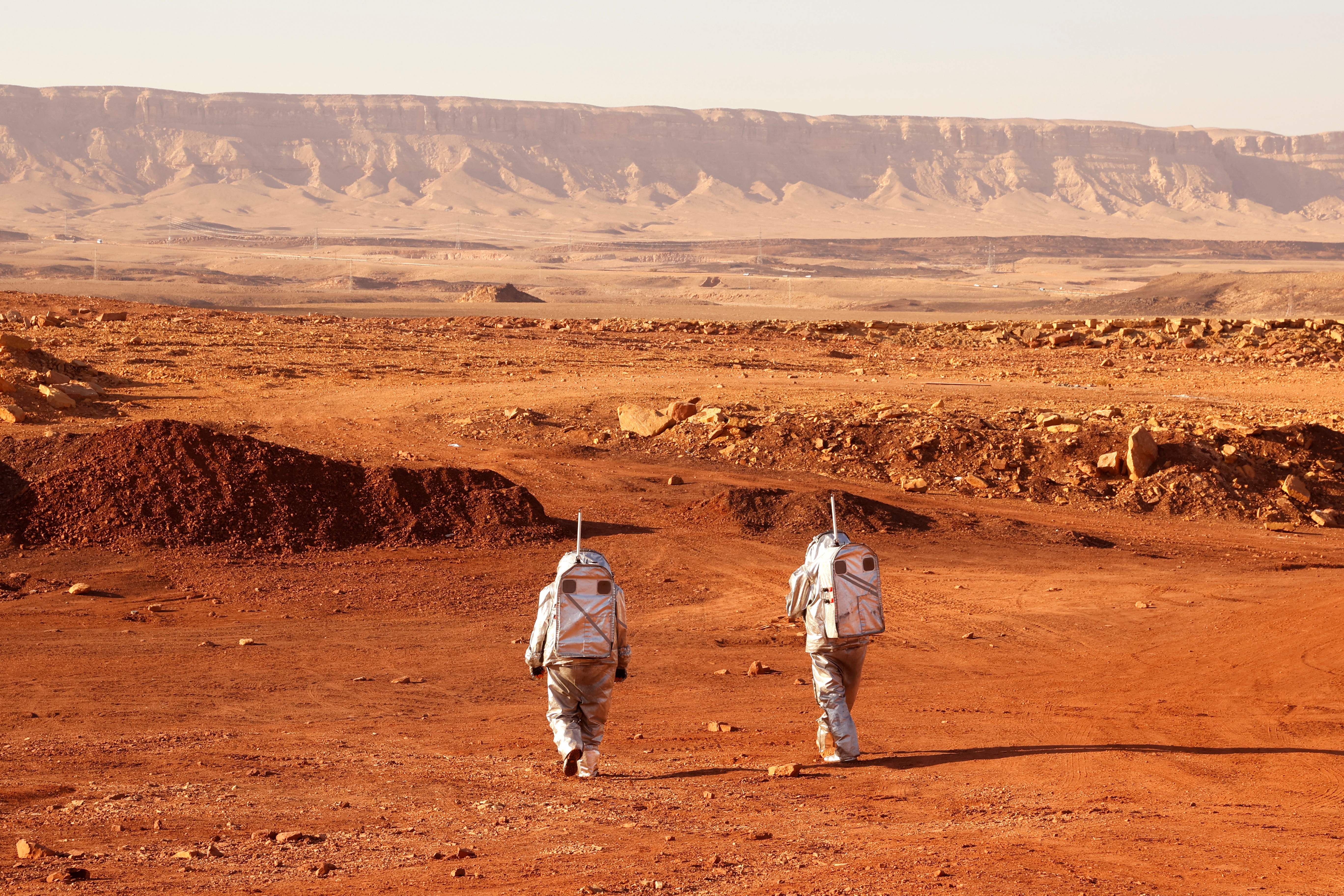
Sign up to our free weekly IndyTech newsletter delivered straight to your inbox
Sign up to our free indytech newsletter, thanks for signing up to the indytech email.
Long space missions are damaging astronauts ’ brains , scientists have said.
Experts now suggest that those who are spending a long time in space should take three years to allow their brains to recover from the changes experienced during their journeys.
Those are the findings of a new study looking at how brain’s react to leaving Earth’s gravity. It comes ahead of what is expected to be a new era of long journeys around space, including the first missions to Mars.
Researchers looked at brain scans of 30 astronauts, taken before and after they travelled to space. They found that journeys over six months left the brain’s ventricles significantly expanded – and they could take up to three years to recover.
The ventricles are cavities in the brain that are filled with a fluid that protects and nourishes the brain, as well as removing waste. Usually, that fluid is helpfully distributed around the body, but the lack of gravity in space can mean that the fluid is pushed upward and shoves the brain higher in the skull.
“We found that the more time people spent in space, the larger their ventricles became,” said Rachael Seidler, a professor of applied physiology and kinesiology at the University of Florida and an author of the study. “Many astronauts travel to space more than one time, and our study shows it takes about three years between flights for the ventricles to fully recover.”
Of the 30 astronauts in the study, eight had been to space for two weeks, 18 went on six-month missions, and four travelled for a year. After two weeks, the brain had not noticeable changed, and after six months the changes appeared to stop.
That is helpful for those involved in short trips of the kind that are being offered through tourism projects such as those from SpaceX.
It might also be helpful to those astronauts who are going on long journeys, such as those to Mars. Researchers are yet to examine those who have travelled for more than a year – but the lack of changes between six and 12 months may also be good news for those long journeys.
“We were happy to see that the changes don’t increase exponentially, considering we will eventually have people in space for longer periods,” said Professor Seidler..
Join our commenting forum
Join thought-provoking conversations, follow other Independent readers and see their replies
Subscribe to Independent Premium to bookmark this article
Want to bookmark your favourite articles and stories to read or reference later? Start your Independent Premium subscription today.
New to The Independent?
Or if you would prefer:
Want an ad-free experience?
Hi {{indy.fullName}}
- My Independent Premium
- Account details
- Help centre
Space Radiation Will Damage Mars Astronauts' Brains
It's probably not a showstopper, though.

Space radiation will take a toll on astronauts' brains during the long journey to Mars , a new study suggests.
Mice exposed for six months to the radiation levels prevalent in interplanetary space exhibited serious memory and learning impairments, and they became more anxious and fearful as well, the study reports.
The trip to Mars takes six to nine months one way with current propulsion technology. So, these results should ring a cautionary bell for NASA and other organizations that aim to send people to the Red Planet, study team members said.
Related: How Space Radiation Threatens Human Exploration (Infographic)
"This is not a deal-breaker for space travel, but when you send astronauts up there, you have to be prepared for what some of the consequences are for being exposed to these radiation fields," said study co-author Charles Limoli, a professor of radiation oncology at the University of California, Irvine (UCI) School of Medicine.
"These chronic low-dose-rate, low-dose-exposure scenarios are going to increase the risk of developing, perhaps, mission-critical performance deficits," Limoli told Space.com. "What exactly those are, we'll never know until we get out there."
Researchers investigating the effects of deep-space radiation have historically given lab animals acute doses — high levels over a relatively short period of time. But Limoli and his colleagues — led by Munjal Acharya and Janet Baulch of UCI's Department of Radiation Oncology and Peter Klein of Stanford University's Department of Neurosurgery — took a different tack.
Get the Space.com Newsletter
Breaking space news, the latest updates on rocket launches, skywatching events and more!
Using a neutron-irradiation facility, they exposed 40 mice to 1 milligray of radiation per day (1 mGy/day) for six months, about the same dose and duration that astronauts would experience on a trip to or from Mars . (Astronauts in low Earth orbit are exposed to lower doses, because they're protected by our planet's magnetosphere.)
"This is the first study that's looked at space-relevant dose rates," Limoli said. "And this is the first study to analyze the consequences of the low dose rate over the course of time on functional endpoints in the brain."
The researchers analyzed the behavior of these mice over the course of the study, measuring the animals' ability to learn and remember information, their willingness to interact with new mice introduced into their enclosure, and other variables. And at the end of the six months, the scientists euthanized the mice and studied their brains, looking for physiological changes.
All of these measurements and observations were compared with those gathered from a control group of 40 mice, which did not receive the 1 mGy/day dose.
Related: How Living on Mars Could Challenge Colonists (Infographic)
The results were striking. Radiation-exposed mice exhibited more stress behaviors and a decreased ability to learn and remember. The physiological work bolstered these behavioral findings, identifying impaired cellular signaling in two key areas of the brain : the hippocampus, which is associated with learning and memory, and the prefrontal cortex, the site of many complex cognitive functions.
The researchers said they aren't sure what caused these physiological effects in the brain; the team didn't trace out the molecular pathways involved. But the low radiation doses employed suggest that the impacts are probably not the result of cell death or DNA damage, Limoli said.
NASA is keenly aware of, and interested in, these results; the space agency helped fund the new study , which was published Monday (Aug. 5) in eNeuro, the Society for Neuroscience's open-access journal.
The anxiety and depression effects shouldn't be a big deal for NASA going forward, Limoli said; the agency can screen potential Mars astronauts with such impacts in mind. But the learning and memory impairments present a more serious concern, he added.
The effects of chronic radiation exposure "would probably manifest in a scenario where the astronauts have to deal with some unanticipated event where there's some on-the-spot decision-making or problem-solving involved," Limoli said.
"Is it going to cause them to forget their long-term memories or forget how to fly the spacecraft? Of course not," he added. "But these subtle manifestations of impairment may prove problematic under certain emergencies, for example."
Limoli stressed that low-dose, background radiation exposure is not a showstopper for crewed Mars missions. Rather, it's a significant risk-increasing factor that needs to be taken into consideration when planning such trips, which NASA aims to achieve in the 2030s.
But the story may well be different for interstellar flight , which will require much longer travel times (barring big breakthroughs in propulsion technology, of course) — and therefore much higher cumulative radiation exposures for anyone aboard.
"I anticipate that the radiation problem in space may be one of the biggest problems humans ever have to solve to get out of the solar system," Limoli said. "The radiation in space may keep us in our solar system for a long time."
- Anti-Radiation Vest to Get Deep-Space Test Next Year
- How We Could Make Mars Habitable, One Patch of Ground at a Time
- These Stunning Designs Show What Our Future on Mars Might Look Like
Mike Wall's book about the search for alien life, " Out There " (Grand Central Publishing, 2018; illustrated by Karl Tate ), is out now. Follow him on Twitter @michaeldwall . Follow us on Twitter @Spacedotcom or Facebook .
Join our Space Forums to keep talking space on the latest missions, night sky and more! And if you have a news tip, correction or comment, let us know at: [email protected].

Michael Wall is a Senior Space Writer with Space.com and joined the team in 2010. He primarily covers exoplanets, spaceflight and military space, but has been known to dabble in the space art beat. His book about the search for alien life, "Out There," was published on Nov. 13, 2018. Before becoming a science writer, Michael worked as a herpetologist and wildlife biologist. He has a Ph.D. in evolutionary biology from the University of Sydney, Australia, a bachelor's degree from the University of Arizona, and a graduate certificate in science writing from the University of California, Santa Cruz. To find out what his latest project is, you can follow Michael on Twitter.
SpaceX to launch 23 Starlink satellites tonight in 2nd half of spaceflight doubleheader
SpaceX Falcon 9 rocket launches 2 satellites on record-tying 20th flight (video)
Astronauts on the moon could stay fit by running in a Wheel of Death
Most Popular
- 2 Watch ULA assemble Atlas V rocket ahead of Boeing Starliner astronaut test flight (video)
- 3 NASA's Hubble Telescope is back in action — but its TESS exoplanet hunter may now be in trouble
- 4 NASA selects Rocket Lab for back-to-back climate change research launches
- 5 SpaceX to launch 23 Starlink satellites tonight in 2nd half of spaceflight doubleheader
- Today's news
- Reviews and deals
- Climate change
- 2024 election
- Fall allergies
- Health news
- Mental health
- Sexual health
- Family health
- So mini ways
- Unapologetically
- Buying guides
Entertainment
- How to Watch
- My watchlist
- Stock market
- Biden economy
- Personal finance
- Stocks: most active
- Stocks: gainers
- Stocks: losers
- Trending tickers
- World indices
- US Treasury bonds
- Top mutual funds
- Highest open interest
- Highest implied volatility
- Currency converter
- Basic materials
- Communication services
- Consumer cyclical
- Consumer defensive
- Financial services
- Industrials
- Real estate
- Mutual funds
- Credit cards
- Balance transfer cards
- Cash back cards
- Rewards cards
- Travel cards
- Online checking
- High-yield savings
- Money market
- Home equity loan
- Personal loans
- Student loans
- Options pit
- Fantasy football
- Pro Pick 'Em
- College Pick 'Em
- Fantasy baseball
- Fantasy hockey
- Fantasy basketball
- Download the app
- Daily fantasy
- Scores and schedules
- GameChannel
- World Baseball Classic
- Premier League
- CONCACAF League
- Champions League
- Motorsports
- Horse racing
- Newsletters
New on Yahoo
- Privacy Dashboard
On a Long Trip to Mars, Cosmic Radiation May Damage Astronauts' Brains
President Barack Obama has reaffirmed his vision to send humans to Mars . In an editorial posted on CNN.com today (Oct. 11), the president wrote of his goal of "sending humans to Mars by the 2030s and returning them safely to Earth, with the ultimate ambition to one day remain there for an extended time."
NASA Administrator Charles Bolden echoed the president's enthusiasm, describing in a blog post today co-written with John Holdren, a senior adviser to the president, how NASA plans to "utilize public-private partnerships to enable humans to live and work in space in a sustainable way."
Key to the ambitious endeavor, however, is ensuring the astronauts' safety, which may be difficult, according to a NASA-funded study published yesterday (Oct. 10) in the journal Scientific Reports.
The new study, in rodents, shows that astronauts could suffer from a phenomenon called "space brain" during the long trip to Mars , as cosmic radiation bombards their bodies and damages their brain cells.
Researchers exposed the laboratory-bound rodents to a level of radiation similar to that expected on a six-month one-way trip to Mars. They found that the radiation caused significant long-term brain damage, including cognitive impairments and dementia, a result of brain inflammation and damage to the rodents' neurons. [ 10 Things You Didn't Know About the Brain ]
The researchers said the new study revealed a far greater extent of brain damage than what was hinted at in their shorter, six-week study, conducted last year.
"This is not positive news for astronauts deployed on a two- to three-year round-trip to Mars," said Charles Limoli, a professor of radiation oncology at the University of California, Irvine School of Medicine, who led the study.
NASA told Live Science that the agency is funding such studies to better understand the risks posed to its astronauts, although the agency was not aware that Limoli's study was published and could not comment on the details.
Radiation hazards
Astronauts in space face two kinds of radiation hazards. One is the solar radiation from the sun, including ultraviolet rays , X-rays, protons and electrons. The other is cosmic radiation, which emanates from all directions in deep space and comprises atomic particles far more energetic (and thus more damaging) than solar radiation.
Limoli's research was aimed at assessing the possible human health problems that could be caused by cosmic radiation on a prolonged space journey. There are almost no studies so far that have looked at this, Limoli said. Humans have lived on the International Space Station (ISS) for months at a time. Russian cosmonaut Valeri Polyakov (born Valeri Ivanovich Korshunov but later changed his name) holds the record for the longest, continuous time in orbit — almost 438 days aboard the Mir space station.
However, because Mir (which is no longer in use) and the ISS are relatively close to Earth, Earth's magnetosphere — a natural magnetic field that deflects charged atomic particles from the sun and deeper space — mostly protects astronauts on board the orbiting labs from dangerous radiation exposure. Tests have shown that Polyakov and other astronauts have no serious brain damage as a result of their time in orbit. [ 5 Mars Myths and Misconceptions ]
Astronauts who visited the moon ventured beyond this protective magnetosphere, but their entire round-trip lasted only about two weeks, so their radiation exposure was kept to a minimum. One previous study , done in 2013 in mice, suggested that radiation may hasten the development of Alzheimer's.
To simulate the cosmic radiation exposure humans would face during a long Mars trip, Limoli's group exposed rodents to charged particles at the NASA Space Radiation Laboratory at the Brookhaven National Laboratory in Upton, New York.
The researchers found that although the bombardment of the radiation was painless, it caused significant brain damage in the rodents. Imaging revealed that the animals' brain cells had a sharp reduction in features of the cells called the dendrites and spines, which would disrupt the transmission of signals among neurons , they said.
Limoli told Live Science that loss of dendrites and spines were "like a tree losing its leaves and branches," compromising the health of the tree. These physical losses explained the deficiencies the rodents showed in behavioral tasks designed to test learning and memory , Limoli said. In humans, this loss could lead astronauts to make poor decisions that could affect the safety of the crew, he added.
The researchers also discovered that the radiation affected the part of the brain that normally suppresses prior unpleasant and stressful associations, as part of a process called "fear extinction." This loss of fear extinction could make the astronauts prone to anxiety, Limoli said. [ Infographic: How Radiation Affects the Human Body ]
Yet Limoli remains optimistic that NASA can still send astronauts safely to Mars. "This is not a deal breaker," he told Live Science. "This [cosmic radiation] is simply something we have to deal with."
A 30-month trip
NASA estimates that a 30-month trip to Mars — six months of travel each way, plus 18 months living on the Red Planet — would expose astronauts to a total of 1 sievert (Sv) of radiation. For comparison, Limoli said people who undergo certain kinds of radiation treatment for brain cancer may need to endure a dose at least 10 times higher than that through the course of that treatment. He said that these cancer patients, although they may be cured of cancer, have notable declines in their cognitive function.
Astronauts could be protected from cosmic radiation in two ways, a NASA press officer told Live Science. One would be to a passive method of installing thick metal shields or layers with water, either around the entire spacecraft or around sleeping chambers to block the radiation. Cosmic radiation is very penetrating, however, and shields that would be thick enough to block the rays would add considerable weight (and thus, expense) to the Mars mission .
Another way is an active method of installing an electromagnetic field to deflect the radiation, analogous to the magnetosphere itself. Limoli said his group and others are working on another strategy, medicines that could repair the damage caused by radiation, or protect or even restore neurons.
It will certainly be a memorable trip to Mars, and NASA hopes the astronauts will stay healthy enough to remember it.
Follow Christopher Wanjek @wanjek for daily tweets on health and science with a humorous edge. Wanjek is the author of "Food at Work" and "Bad Medicine." His column, Bad Medicine , appears regularly on Live Science.
Editor's Recommendations
Top 10 Mysteries of the Mind
7 Most Mars-like Places on Earth
6 Foods That Are Good for Your Brain
Recommended Stories
Caitlin clark catches fire from 3 in wnba preseason; arike ogunbowale's late heroics send wings past fever.
Caitlin Clark’s WNBA preseason debut went much like her senior year at Iowa. She hit a bunch of 3s and did so in front of a sold-out crowd.
NFL Power Rankings, draft edition: Did Patriots fix their offensive issues?
Which teams did the best in the NFL Draft?
2024 NFL Draft grades: Denver Broncos earn one of our lowest grades mostly due to one pick
Yahoo Sports' Charles McDonald breaks down the Broncos' 2024 draft.
Formula 1: Miami Grand Prix sends cease and desist letter to prevent Donald Trump fundraiser during race
Race organizers say they'll revoke a Trump fundraiser's suite license if he holds an event for the former president on Sunday at the race.
How to watch the 2024 WNBA preseason tonight: Caitlin Clark’s next Indiana Fever game time, channel and more
The WNBA preseason tips off this Friday. Here's how you can catch Caitlin Clark's first game.
NFL Draft grades for all 32 teams | Zero Blitz
Jason Fitz and Frank Schwab join forces to recap the draft in the best way they know how: letter grades! Fitz and Frank discuss all 32 teams division by division as they give a snapshot of how fans should be feeling heading into the 2024 season. The duo have key debates on the Dallas Cowboys, New York Giants, New Orleans Saints, Los Angeles Rams, New England Patriots, Las Vegas Raiders and more.
New details emerge in alleged gambling ring behind Shohei Ohtani-Ippei Mizuhara scandal
It turns out the money was going from Ohtani's bank account to an illegal bookie to ... casinos.
The best RBs for 2024 fantasy football according to our analysts
The Yahoo Fantasy football analysts reveal their first running back rankings for the 2024 NFL season.
Lakers fire head coach Darvin Ham after just 2 seasons, latest playoff series loss to Nuggets
Despite a trip to the Western Conference finals in his first season with the team, the Lakers are now ready to look for a replacement for Darvin Ham.
CVS stock plunges after earnings numbers one analyst 'did not even believe'
CVS warns it could cede Medicare Advantage market share as reimbursement rates pressure the company.
Fantasy Baseball Waiver Wire: 7 pickups ready to improve your squad
Andy Behrens has a fresh batch of priority adds to help give your fantasy team a boost, led by a player set to make his season debut.
Acura’s new all-electric SUV proves the most expensive model isn’t always the best
The first electric vehicle I ever drove was a Tesla Roadster in 2011. It was with great anticipation that I slid behind the wheel of the 2025 Acura ZDX Type S. Sure, it's a midsize SUV, but it wears the Type S moniker, a name reserved only for the most fun-to-drive in the Acura stable. On launch, the ZDX will be available in A-Spec and Type S trims -- both of which come equipped with a 102 kWh battery.
Diana Taurasi’s trash-talking, in-your-face ways may be a bit of a shock to new WNBA fans
Caitlin Clark fans beware: You never know what the 20-year veteran might say … or do.
NBA playoffs: Kyrie Irving takes over to lead Mavericks past Clippers into 2nd-round matchup vs. Thunder
A tepid Clippers offense had no answer for Irving and Luka Dončić in an elimination game.
Wide receiver rankings for fantasy football 2024
The Yahoo Fantasy football analysts reveal their first wide receiver rankings for the 2024 NFL season.

Tight end rankings for 2024 fantasy football 2024
The Yahoo Fantasy football analysts reveal their first tight end rankings for the 2024 NFL season.
NBA playoffs: Bucks G Patrick Beverley chucks ball at multiple Pacers fans amid elimination
PatBev made the Bucks' playoff exit even uglier.
MLB Power Rankings: Braves move into the top spot followed by Dodgers, Phillies as injuries take a toll across the league
From the Braves to the Marlins, here's where all 30 teams stand after the season's first month.
Tiger Woods explains viral Masters tree meme, daughter’s ‘negative’ relationship with golf while promoting ‘Sun Day Red’
Jimmy Fallon asked Tiger Woods all about his incredible handshake with Verne Lundquist at the Masters on Tuesday night.
Reba McEntire, 69, relies on this wrinkle-smoothing 'holy grail' moisturizer for radiant skin
Her makeup artist swears by it for this clever foundation trick for dewy, glowing coverage.
Subscribe or renew today
Every print subscription comes with full digital access
Science News
Zipping to mars could badly zap brain nerve cells.
Particle blasts similar to cosmic radiation caused memory, learning woes in mice

BRAIN ZAP After radiation exposure, mouse dendrites (green) in the medial prefrontal cortex were shorter and branched less than those of mice not exposed to radiation, as seen in this digital reconstruction. Exposed dendrites also had fewer docking sites (red) that detect messages from other cells.
V. Parihar et al/Science Advances 2015
Share this:
By Laura Sanders
May 1, 2015 at 2:00 pm
Like cannonballs slamming into stained glass, high-energy particles can shatter the delicate tendrils that connect nerve cells, a study on mice finds. This neural destruction left mice with memory and learning problems, a finding that has implications for intrepid space explorers.
The result is “worrisome, very worrisome,” says neuroscientist M. Kerry O’Banion of the University of Rochester Medical Center in New York. But figuring out the human brain’s fate on a long space trip is tricky, he notes.
In the study, Charles Limoli of University of California, Irvine and colleagues briefly exposed mice to a beam loaded with high-energy versions of either titanium or oxygen, particles an astronaut might encounter in deep space. Six weeks after the quick zap, the mice showed memory deficits. Compared with nonirradiated mice, zapped animals were worse at recognizing new toys and remembering where a particular toy used to be, the team reported May 1 in Science Advances .
Brain damage also occurred. Complex branches of nerve cells that receive messages were shorter and the cells had fewer branches after the radiation, the team found. “We weren’t expecting such dramatic effects from these charged particles,” says Limoli.
During a long-haul mission to Mars, astronauts would surely encounter these sorts of particles, Limoli says. This study suggests that these encounters could damage astronauts’ brains, perhaps in ways that lead to cognitive problems during the mission and afterward. “Over the course of a long-term mission, this may become very problematic,” Limoli says.
Translating the mouse study to people is difficult, O’Banion says. “There are big differences in the way the animals are exposed to the radiation versus how astronauts are,” he says. Space holds a more complex mixture of particles than those in the beam, and the doses differ, too. The biological response to radiation is, in many ways, “still a black box,” O’Banion says.
A deeper understanding of how these particles affect the body and brain may help scientists create better ways to shield vulnerable tissues from space radiation ( SN: 7/26/14, p. 18 ).
More Stories from Science News on Neuroscience

Rat cells grew in mice brains, and helped sniff out cookies

These windpipe cells trigger coughs to keep water out of the lungs

Tiny treadmills show how fruit flies walk

In ‘Get the Picture,’ science helps explore the meaning of art

Chickadees use memory ‘bar codes’ to find their hidden food stashes

Here’s how magnetic fields shape desert ants’ brains

Dogs know words for their favorite toys

Ancient viruses helped speedy nerves evolve
Subscribers, enter your e-mail address for full access to the Science News archives and digital editions.
Not a subscriber? Become one now .
The real cost of a trip to Mars could be brain damage
Scientists say the voyage to Mars could turn you into a basket case. And that's before arriving on a planet with dozens of ways to kill you.

- Finalist for the Nesta Tipping Point prize and a degree in broadcast journalism from the University of Missouri-Columbia.
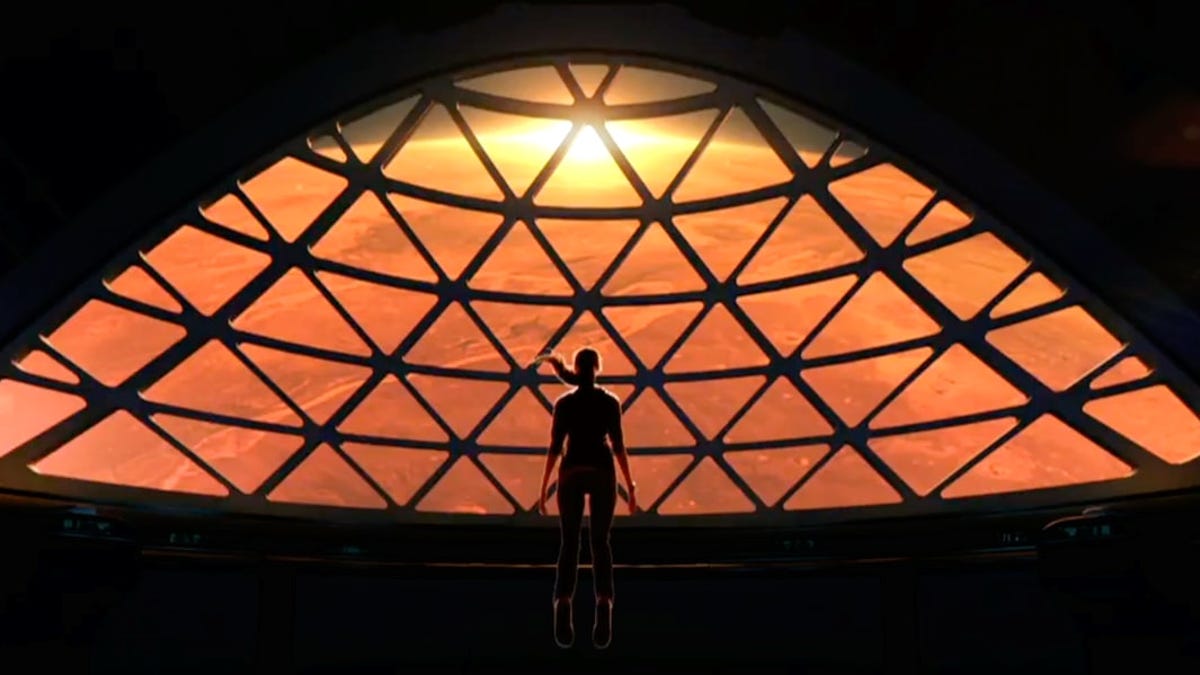
Last month, SpaceX founder Elon Musk detailed his ambitious plan to build a city on Mars during this century, drawing praise, mockery and everything in between.
The billionaire CEO, who also runs Tesla Motors, focused his presentation on the transportation system between Earth and the Red Planet that Space X is developing, while glossing over the myriad other challenges presented by the notion of a Martian metropolis.
New research shows the long trip to Mars could leave astronauts and colonists diminished or even brain damaged by the time they arrive on the planet, which other scientists remind us is hostile to human life.
Scientists at the University of California-Irvine have been studying a condition they call "space brain" that could affect space travelers on the extended trip to Mars. During the trip, which would likely take at least nine months each way, travelers would be bombarded by cosmic rays of highly-charged particles that can cause a variety of serious, long-term problems.
"Exposure to these particles can lead to a range of potential central nervous system complications that can occur during and persist long after actual space travel," said UCI professor of radiation oncology Charles Limoli in a release , "such as various performance decrements, memory deficits, anxiety, depression and impaired decision-making. Many of these adverse consequences to cognition may continue and progress throughout life."
Limoli and his team studied the effects of charged particle irradiation on rodents at NASA's Space Radiation Laboratory at New York's Brookhaven National Laboratory. Their findings were published Monday in the journal Scientific Reports .
Six months after exposure, the researchers found evidence of brain damage in the rodents, particularly in areas that affect learning and memory. The radiation also affected something called "fear extinction," which is basically the brain's ability to convince you not to spend the rest of your life freaking out after something bad happens. It's what allows you to get in a car again after you've been in an accident, for example.
A look at Elon Musk's plan to move us to Mars (pictures)
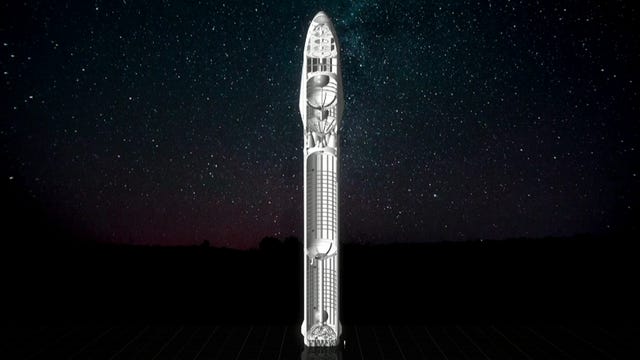
"Deficits in fear extinction could make you prone to anxiety," Limoli said, "which could become problematic over the course of a three-year trip to and from Mars."
During a speech at the International Astronautical Conference in September, Musk said "The radiation thing is often brought up, but I think it's not too big of a deal." SpaceX didn't immediately respond to a request for comment.
I contacted Dr. Jim Logan, who spent two decades as a medical expert at NASA, to ask about the health challenges of traveling to and living on Mars. He told me he worries that Musk's cavalier attitude toward such risks "may have set back the very worthy goal of making humanity a celestial species by decades."
"The one statement in (Musk's) presentation I agree with one hundred percent is many people will die," Logan wrote in an email. He called the vision of colonizing Mars in the coming decades "the equivalent of hyping flying cars and personal jet packs in the 1950s."
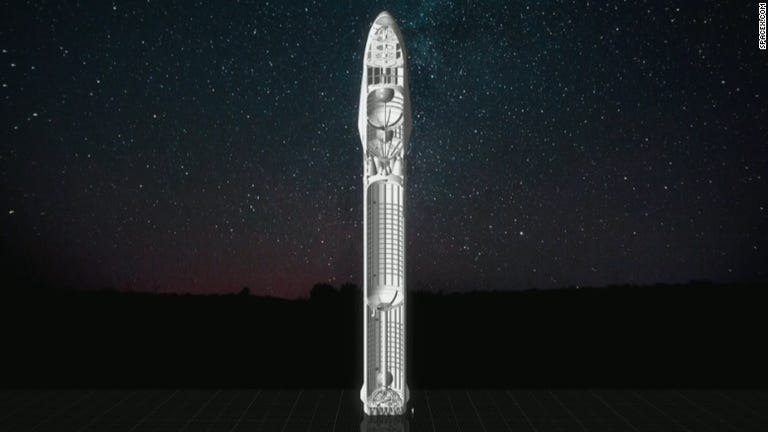
This tension between scientific realists and entrepreneurial visionaries over humanity's next steps into space has become more pronounced over the pasts few years as high-profile, private commercial space companies like SpaceX and Jeff Bezos' Blue Origin have emerged and government space agencies have stagnated when it comes to sending humans beyond orbit.
Related stories
- Before signing up for Mars, consider all the ways you could die there
- Elon Musk unveils epic SpaceX plan to colonize Mars
- Elon Musk's Mars metropolis: Insane but not impossible
- Why the best Mars colonists could come from places like Iran and Brazil
Mars One's controversial plan to create a Martian colony via a reality-show style competition drew criticism from researchers who declared colonists would die within a few months on the surface of Mars . Even the founder of the Mars Institute has given presentations on all of the dozens of ways to die on Mars .
Yet, I'd bet SpaceX and Mars One continue to have no shortage of volunteers willing to die on (or on the way to) Mars. Over 200,000 people expressed interest in a one-way trip to the Red Planet with Mars One, and that promises to be far less comfortable than the futuristic space colony of one million earthlings Musk envisions.
Science and realists will continue to chip away at the more romantic notions of Mars, but humans have been known to ignore such practical, reasoned concerns. Eventually, our descendants may tell stories about migration to Mars or beyond.
SpaceX, NASA dream of selling dream trips (pictures)


Astronauts on Mars missions could suffer cognitive and emotional problems – new research
Senior Lecturer, Department of Psychology, Royal Holloway University of London
Disclosure statement
Elisa Raffaella Ferrè does not work for, consult, own shares in or receive funding from any company or organisation that would benefit from this article, and has disclosed no relevant affiliations beyond their academic appointment.
Royal Holloway provides funding as a member of The Conversation UK.
View all partners
Human space missions to Mars are the next great leap in space exploration, with Nasa targeting the 2030s as a reasonable time frame for taking the first humans there . But boarding on a journey to Mars is not like catching a flight to New York. Space is an extremely hostile environment for human life – from the lack of gravity and harmful radiation to isolation and the absence of night and day.
Listen to an audio version of this story.
Deep space missions to Mars will be much more physically and mentally demanding than the journeys we’ve made so far during 60 years of human space exploration. A flight to Mars and back will last approximately 14 months, while the actual exploration mission will last at least three years. Sustained high levels of cognitive performance and effective teamwork are prerequisites for the safe and success outcome of these missions.
But a new study, published in Frontiers of Physiology , has discovered that the lack of gravity on such missions could have a negative impact on astronauts’ cognitive skills and emotional understanding.
Since the first space missions, it has been clear that exposure to “microgravity” (weightlessness) leads to dramatic changes in the human body . This includes alterations in the cardiovascular, musculoskeletal and neural systems. On Earth, we detect gravity with the help of our vision and various organs, including those inside the inner ear. When our head is upright, small stones in the ears – the vestibular otoliths – are balanced perfectly on a viscous fluid. But when we move the head, gravity makes the fluid move and this triggers a signal to the brain that our head has changed position. In spaceflight, this process no longer works.
Spaceflight can even adversely alter the anatomy of astronauts’ brains. Structural brain changes have been observed in astronauts after returning from the International Space Station (ISS). These include the brain physically moving upwards inside the skull and a reduced connectivity between areas on the layer of the brain, the cortex, and those inside.
How these changes affect behaviour is not yet fully understood, but scientists are making progress . We know that astronauts can suffer from disorientation, perceptual illusions, balance disorders and motion sickness. But such findings are often based on small samples.
Simulating microgravity
The new Nasa-supported study investigated the effects of microgravity on cognitive performance. But rather than sending their 24 study participants to space, they sent them to bed. That’s because the impact of a certain type of bed rest is analogous to the effects of microgravity – we use it a lot in research. When we are upright, our body and vestibular otoliths are in the same direction as gravity, while when we are lying down they are orthogonal (at right angles).

The participants in the study therefore had to lay on their backs at an inclination of 6° angle, with the head lower than the body, for nearly two months without changing position. They were asked to regularly perform a series of cognitive tasks designed for astronauts and relevant to spaceflight in order to evaluate their spatial orientation, memory, risk-taking behaviour and emotional understanding of others.
Results showed a small but reliable slowing of cognitive speed in tasks involving sensory and motor skills. This seems to be coherent with reported changes in brain tissue density over the “sensorimotor cortices”, the primary sensory and motor areas of the brain which help process sensory inputs and movements, observed after spaceflight. Participants also had difficulty in reading emotions when looking at people’s faces.
Adjusting to changes in gravity requires time and effort. While the performance on most cognitive tasks initially declined, after about 60 days they then remained unchanged over the course of the experiment. But the ability to recognise emotions continued to worsen. In fact, participants became biased towards negative emotions – they were more likely to identify other people’s facial expressions as angry and less likely to interpret them as happy or neutral.
This is an important finding. The ability of astronauts to be sharp and quick thinkers is crucial to a space mission. So is the capability to correctly “read” each other’s emotional expressions, given they have to spend a lot of time cooped up together in a small space. Space agencies should therefore consider adequate pre-flight psychological training as well as in-flight psychological support in order to minimise this risk.
Recent advancements and investment in rocket technology are ushering in a new and exciting age of space exploration. Microgravity can be profoundly unsettling and can compromise performance levels in many ways. With an eye towards deep-space human missions to Mars, it is a pressing research goal to get a better insight into how microgravity influences cognitive performance and emotional health, as well as develop appropriate medical and psychological support for spaceflight.
- Space exploration
- Mars mission
- Audio narrated

Assistant Editor - 1 year cadetship

Program Development Officer - Business Processes

Executive Dean, Faculty of Health

Lecturer/Senior Lecturer, Earth System Science (School of Science)

Sydney Horizon Educators (Identified)
Deep Space Travel Could Damage Astronauts’ Brains
Rodents suffer from cognitive problems months after encountering space-like radiation
By Kate Baggaley | Published Oct 14, 2016 12:00 AM EDT
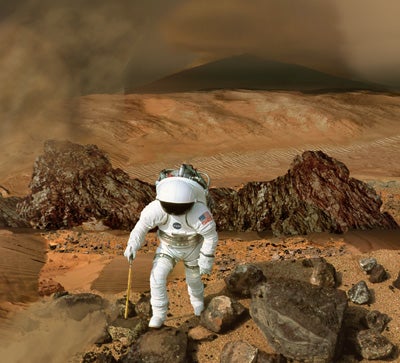
On a mission to Mars, future astronauts will have to leave the protection of Earth’s magnetic field. As they head into deep space, high-energy galactic cosmic rays will pass through the hull of their ship and into their bodies. This might have dangerous—and lasting—consequences for the astronauts’ health.
A new study in rodents has found brain damage and cognitive problems six months after the animals were exposed to space-like radiation at doses similar to what astronauts would encounter. The findings suggest that space radiation could cause astronauts to suffer from memory problems, anxiety, and impaired judgment.
“This is not a deal-breaker,” says coauthor Charles Limoli, a neurobiologist at the University of California, Irvine. “I do not think that during the course of a trip to Mars and back the astronauts will come back with anything remotely similar to full-blown Alzheimer’s. But more mild changes, more subtle changes—they would still be concerning, given the level of autonomy astronauts operate under and the amount of work they have to do.”
The work builds on a study from last year that uncovered problems in mouse brains and behavior six weeks after they were exposed to radiation. Now, the team has found that irradiated rodents falter on more learning and memory tests, and that their problems continue over a longer timeframe.
Compared with other rodents, mice that were exposed to radiation become less interested in investigating new toys, or toys moved to new locations in their enclosures. Irradiated rats became less flexible in responding to changes in their environment.
The rodents also appeared to be more anxious, preferring to remain sheltered within the covered arm of a maze rather than venturing into more open terrain. They seemed to have trouble unlearning or forgetting stressful associations, Limoli says. The animals could not extinguish their fear.
In humans, this might translate to “elevated stress, anxiety and otherwise disadvantageous responses in unexpected or emergency situations,” the team wrote in their paper, published October 10 in Scientific Reports . Astronauts might also suffer memory problems, or struggle with multitasking and making on-the-spot decisions. “And of course there may be some elevated risk for developing some more advanced dementia once they return to Earth,” Limoli says.
He and his colleagues also investigated the brain damage that might underlie these problems. In the areas they examined, the neurons’ dendrites—the spiky structures that receive input from other nerve cells—were studded with “dramatically” fewer spines. These spines help pass signals between neurons, enabling learning and memory. “When we look at those animals that perform the poorest on a given behavioral task, those animals show the largest reductions in these dendritic spines,” Limoli says.
He and his colleagues also found lasting inflammation in the rodents’ brains. This “inflammatory footprint” can rouse immune cells and lead to dendrites becoming pruned and trimmed.
What the team did not find was any sign that the animal’s brains were recovering from their ordeal. “That was actually one of the more surprising findings,” Limoli says. “These changes don’t in fact resolve, or at least not that we can detect.”
In fact, the team’s ongoing experiments suggest that these problems continue to linger. “The actual time that these animals are irradiated here on Earth … is a matter of minutes, and we see changes now that last out to a year, which is astounding,” Limoli says.
In humans, it would likely be months before these detriments became apparent. But until astronauts embark on a deep space mission, we don’t know exactly how people respond to galactic cosmic rays. To prepare, Limoli and his colleagues want to find out which regions in the brain are more vulnerable to space radiation. They are also developing drugs that might help protect the brain from radiation, or help it recover. NASA is also working out how to fortify shielding in areas of the ship where astronauts spend a lot of time, although this would be difficult and expensive.
Still, the team is optimistic. “Our exploration of strange new worlds should not be hampered by the fear of cosmic radiation exposure,” they wrote. Instead, it should inspire us to understand the risks and look for potential solutions.
“I don’t think this means we’re not going to go into space,” says Limoli, “but if we know what’s out there, we can prepare to deal with it much better.”

Kate Baggaley has been contributing regularly to Popular Science since 2017. She frequently covers nature, climate, and the COVID-19 pandemic, but has also reported on many other aspects of science, including space, paleontology, and health. She has a soft spot for birds, deep sea critters, and all kinds of gorgeous creepy crawlies.
Like science, tech, and DIY projects?
Sign up to receive Popular Science's emails and get the highlights.
For IEEE Members
Ieee spectrum, follow ieee spectrum, support ieee spectrum, enjoy more free content and benefits by creating an account, saving articles to read later requires an ieee spectrum account, the institute content is only available for members, downloading full pdf issues is exclusive for ieee members, downloading this e-book is exclusive for ieee members, access to spectrum 's digital edition is exclusive for ieee members, following topics is a feature exclusive for ieee members, adding your response to an article requires an ieee spectrum account, create an account to access more content and features on ieee spectrum , including the ability to save articles to read later, download spectrum collections, and participate in conversations with readers and editors. for more exclusive content and features, consider joining ieee ., join the world’s largest professional organization devoted to engineering and applied sciences and get access to all of spectrum’s articles, archives, pdf downloads, and other benefits. learn more →, join the world’s largest professional organization devoted to engineering and applied sciences and get access to this e-book plus all of ieee spectrum’s articles, archives, pdf downloads, and other benefits. learn more →, access thousands of articles — completely free, create an account and get exclusive content and features: save articles, download collections, and talk to tech insiders — all free for full access and benefits, join ieee as a paying member., a mission to mars could cause serious brain damage, radiation exposure from long-haul space travel could lead to dementia, anxiety, and poor decision-making, according to study in mice and rats.
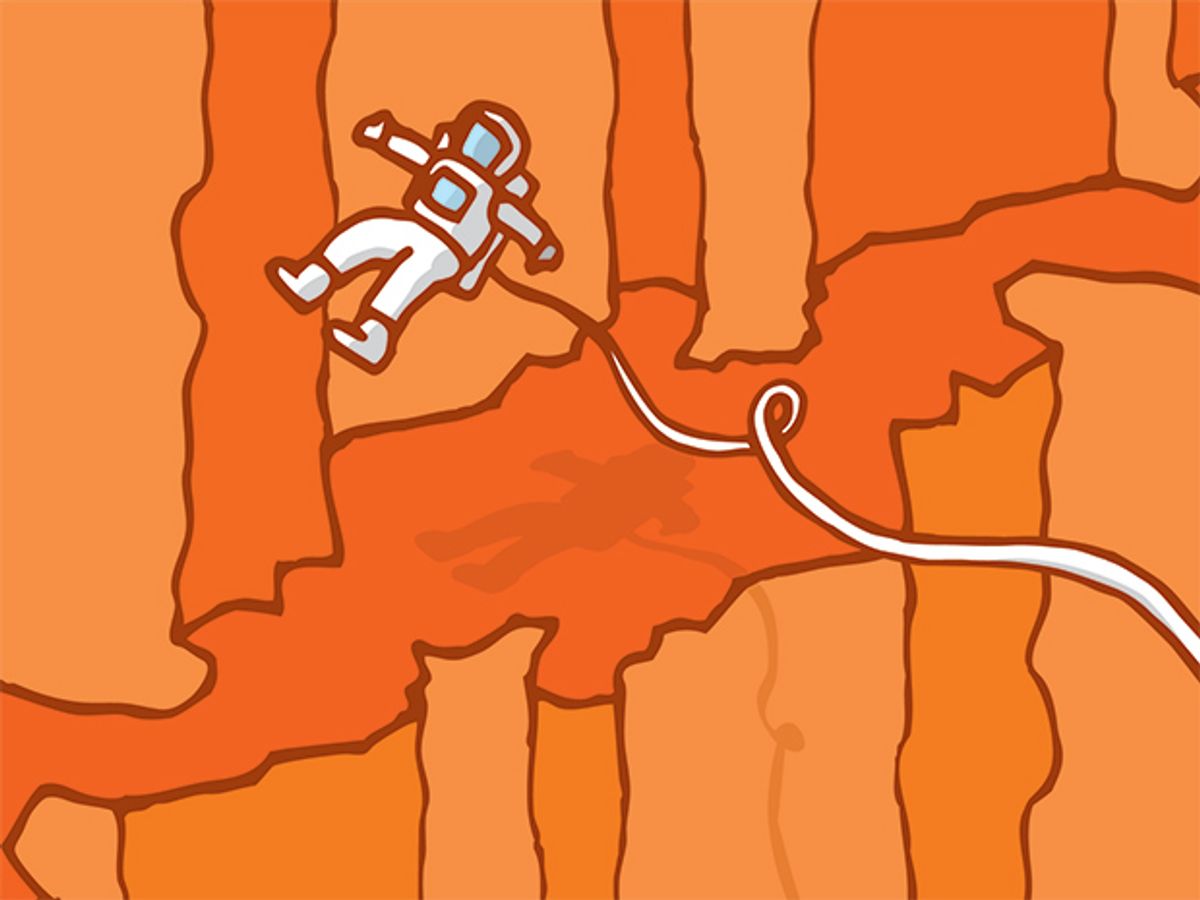
Space is a dangerous place. A new report shows just how dangerous it could be to human brains. Radiation exposure from a Mars missions could cook brain cells, causing chronic dementia and memory loss, and leaving astronauts with debilitating anxiety levels, the study has found. This could throw off their thinking and judgment, impairing decision-making and multi-tasking.
The results, published in Scientific Reports , are based on experiments in rodents. Radiation oncologist Charles Limoli and his colleagues at the University of California Irvine bombarded mice and rats with low-doses of ionized oxygen or titanium. These charged particles have similar energies to those of cosmic rays that can pass right through the shielding on spacecraft. The dosage levels that the researchers used were similar to what astronauts would be exposed to during a three-year round-trip mission to Mars, Limoli says.
The researchers looked at the prefrontal cortex, the brain region linked to decision-making, executive function, and long-term memory. They saw significant damage and inflammation in the brains of exposed animals as long as six months after the exposure.
The radiation damaged the tiny branches on neurons that help transmit electric signals to the nerve cell body. This led to a loss in learning and memory. The exposed animals performed poorly on behavioral tests that measure intelligence, and they showed higher, constant anxiety levels.
“Our tests ask animal to recognize and respond to novelty,” Limoli says. “Smart animals recognize novelty. The affected animals show stress and don’t explore.”
Astronaut Scott Kelly’s 340-day trip aboard the International Space Station was part of NASA’s plan to study the effects of long-term spaceflight on the human body. However, g oing to Mars is a whole different beast than a trip to the moon or the ISS. NASA has been researching the risks of long-haul missions to the red planet and beyond. Limoli’s US $9 million project to investigate how cosmic radiation affects astronauts’ cognition is part of NASA’s Human Research Program.
A six-week study done by the group last year showed similar results. The latest findings, 12 and 24 weeks of measurement, show the long-term nature of brain damage from space travel. “What’s most surprising is how persistent some of the changes to the structure of neurons are,” Limoli says. He adds that his group has unpublished data showing that these effects last for a year.
While the results might not translate directly to humans, he says that it definitely implies that deep space travel could carry huge risks for astronauts. “Space is an inexact science.”
NASA is already investigating ways to mitigate radiation risks. These include thicker shielding, new radiation-blocking materials, protective suits , magnetic fields to recreate Earth’s natural shield. Limoli, meanwhile, is developing drugs that could protect the brain’s circuitry.
This story was corrected on 10 October.
Prachi Patel is a freelance journalist based in Pittsburgh. She writes about energy, biotechnology, materials science, nanotechnology, and computing.
Video Friday: RACER Heavy
As ukraine builds new reactors, renewables beckon, travels with perplexity ai, related stories, the space-based drug factory that can’t come home, the race for the next-gen space station, can this diy rocket program send an astronaut to space.
May 7, 2015
Mars Travelers Could Suffer Radiation Brain Damage
Mice exposed to radiation akin to what astronauts to Mars would receive experienced cognitive impairment. Lee Billings reports
By Lee Billings

Outer space may look mostly empty, but it’s actually packed with cosmic radiation —gamma rays and charged particles produced by exploding stars, black holes and other violent astrophysical phenomena. Earth’s atmosphere and magnetic field keep us safe from the worst of this steady barrage of subatomic bullets. But cosmic radiation would be a constant concern for astronauts on lengthy interplanetary voyages.
NASA and other space agencies have known for decades that this radiation can cause cancer and other cell damage. However, possible effects on mental functioning have been difficult to test. But a new study shows that, in mice at least, cosmic radiation likely causes cognitive impairment. The research is in the journal Science Advances . [Vipan K. Parihar et al, What happens to your brain on the way to Mars ]
The researchers mimicked cosmic-radiation exposure by briefly bombarding the brains of lab mice with high-energy particles. Six weeks later, the mice scored poorly on tests of learning and memory—they displayed less curiosity and more confusion than an unexposed control group. Analysis of their brains revealed inflammation and decreased numbers of dendrites, which transmit signals between nerves.
On supporting science journalism
If you're enjoying this article, consider supporting our award-winning journalism by subscribing . By purchasing a subscription you are helping to ensure the future of impactful stories about the discoveries and ideas shaping our world today.
If humans are similarly susceptible, astronauts on voyages to Mars could suffer permanent cognitive impairment that could hinder their abilities to recall information and to think on their feet. Faster transits, new antiradiation drugs and better spacecraft shielding should help. But until those solutions are developed, sending brain-damaged humans to Mars would be a dim-witted thing to do.
—Lee Billings
[ The above text is a transcript of this podcast. ]
'Space Brain': Mars Explorers May Risk Neural Damage, Study Finds
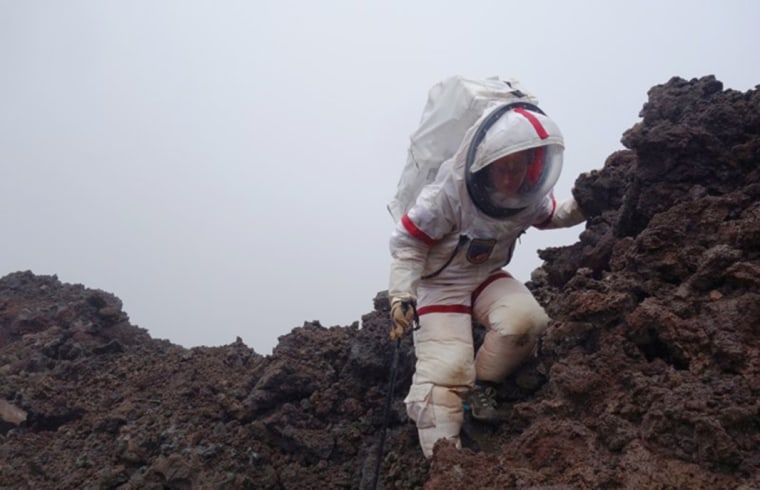
Astronauts making a years-long voyage to Mars may get bombarded with enough cosmic radiation to seriously damage their brains, researchers reported Monday.
The damage might be bad enough to affect memory and, worse, might heighten anxiety, the team at the University of California Irvine said.
It’s the second study the team has done to show that cosmic radiation causes permanent, and likely untreatable, brain damage. While their experiments involve mice, the brain structures that are damaged are similar, they write in the Nature journal Scientific Reports .
“Our data provide additional evidence that deep space travel poses a real and unique threat to the integrity of neural circuits in the brain,” Charles Limoli and colleagues write in their report.
NASA knows that astronauts risk physical damage from the radiation encountered in space. Earth is enveloped in a large, protective sheath called the magnetosphere, which deflects a lot of the ionizing radioactive particles that speed through space.
“Our data provide additional evidence that deep space travel poses a real and unique threat to the integrity of neural circuits in the brain."
Teams aboard the International Space Station are inside that envelope. But moon travelers were not, and this summer a study showed the cosmic radiation may have damaged the hearts of many of the Apollo program astronauts.
A trip to Mars would expose astronauts to even more radiation — enough to cause cancer, for sure, and now this research suggests brain damage, as well.
“Such conditions could clearly be problematic for astronauts and their capability to efficiently operate over the course of a deep space mission,” Limoli’s team wrote.
They bombarded mice with the same type of radiation that would be encountered in space, and then looked at what happened to their brains.
It did not look good. The changes were seen in the connections between brain cells and in the cells, as well.
“Deficits in fear extinction could make you prone to anxiety, which could become problematic over the course of a three-year trip to and from Mars,” Limoli said.
Related: Could Plastic Shield Astronauts From Radiation?
“Exposure to these particles can lead to a range of potential central nervous system complications that can occur during and persist long after actual space travel — such as various performance decrements, memory deficits, anxiety, depression and impaired decision-making. Many of these adverse consequences to cognition may continue and progress throughout life.”
“Using materials that shield more efficiently would cut down on weight and cost, but finding the right material takes research and ingenuity."
NASA has been looking hard at the problem, since a major goal is to get people to Mars by the 2030s.
“There are two ways to shield from these higher-energy particles and their secondary radiation: use a lot more mass of traditional spacecraft materials, or use more efficient shielding material,” NASA said last year on their website. "The sheer volume of material surrounding a structure would absorb the energetic particles and their associated secondary particle radiation before they could reach the astronauts."
But that could get heavy and expensive.
“Using materials that shield more efficiently would cut down on weight and cost, but finding the right material takes research and ingenuity," the agency wrote. "NASA is currently investigating a handful of possibilities that could be used in anything from the spacecraft to the Martian habitat to space suits.”
Maggie Fox is a senior writer for NBC News and TODAY, covering health policy, science, medical treatments and disease.
After Going to Space, You Need to Spend At Least Three Years on Earth Recovering From Brain Damage
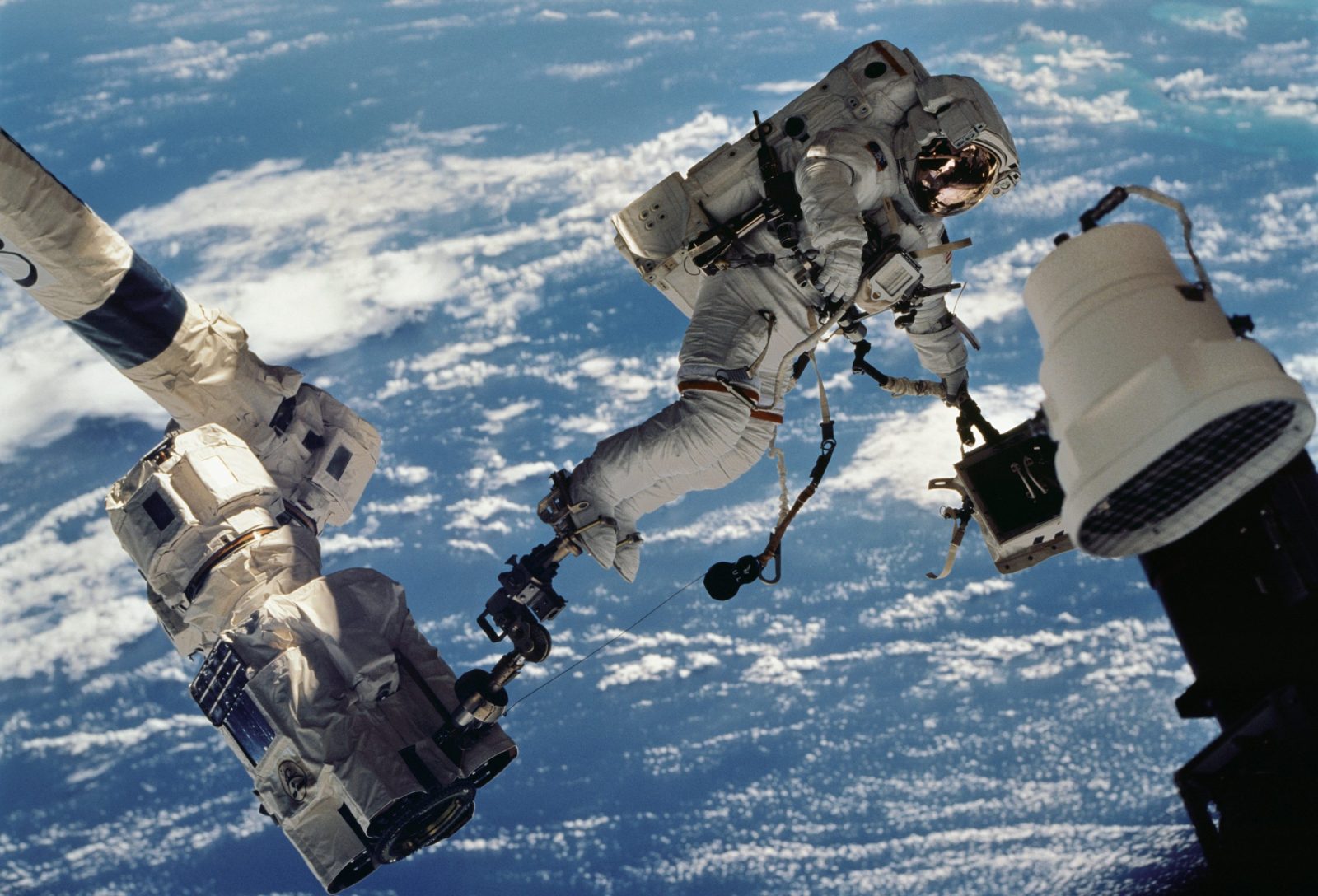
S pace travel is one of the worst things your body can experience. Spending time in zero-g can cause bones to decalcify, muscles to atrophy , the immune system to weaken, the eye to flatten slightly and the optic nerve to swell. Time in space also exposes the human body to unhealthy doses of cosmic radiation, which can increase the lifetime risk of cancer.
Now, astronauts have another part of their body to worry about: the brain. According to a new paper published in Scientific Reports , too much time aloft can cause the brain’s ventricles—cavities filled with cerebrospinal fluid that cushion the brain, nourish tissue, and remove waste—to swell significantly. After astronauts return to Earth, the condition resolves itself only slowly—so slowly in fact that the authors of the paper recommend that all astronauts remain earthbound for extended periods before they are cleared for flight again.
“We found that the more time people spent in space the larger their ventricles became,” said Rachel Seidler, professor of applied physiology and kinesiology at the University of Florida and one of the authors of the study, in a statement. “Many astronauts travel to space more than one time, and our study shows it takes about three years between flights for the ventricles to fully recover.”
More from TIME
Seidler and her 10 co-authors conducted their work using a sample group of 30 astronauts; eight of them had most recently flown short-duration missions no longer than two weeks; 18 had flown six-month missions; and four had been aloft for a year. There were 12 first-time astronauts in the group and 18 who had flown at least twice. They underwent magnetic resonance imaging (MRI) of their brains both before they flew and, on average, six days after their return.
The researchers suspected they might see some brain changes among all 30 of the fliers. In space, fluids in the body tend to migrate upwards, which is why astronauts frequently complain of sinus congestion when they’re aloft and often look slightly puffy-faced when they make TV appearances. Inside the skull, weightlessness has its effect too—and that ought to have a significant impact on the ventricles.
The brain has four ventricles: two lateral ventricles—one each in the brain’s two hemispheres; the third ventricle near the center of the brain; and the fourth ventricle, in the brainstem. All four are connected to the spine and are continuously fed cerebrospinal fluid (CSF), which flows in and out in a regular cycle. In zero-g, that fluid drifts upward, overfilling the ventricles and causing them to increase in size. It also flows back out when the astronauts return to a gravity environment. But the ventricles themselves don’t recover so quickly.
When the researchers conducted their scans, they discovered that the astronauts who had flown two-week missions showed no ventricular enlargement. But for those who had flown six-month and one-year missions, even without excess CSF filling the cavities, the right lateral and third ventricle remained enlarged, anywhere from an additional 11% to 25% of their normal size—and there was no substantial difference between the two groups. “This pattern,” the researchers wrote, “suggests that the majority of ventricular changes in flight occur during one’s first six months in space.”
Added Seidler, in a statement: “We were happy to see that the changes don’t increase exponentially, considering we will eventually have people in space for longer periods.”
The ventricular damage done by zero-g appears to be cumulative. The right lateral ventricle of veteran astronauts, who had flown multiple missions, did not increase in size over the course of their most recent mission as much as the ventricles of the rookies—but that’s not because the veterans were less affected by zero-g. Rather, it’s because the right lateral was still enlarged from their previous flight.
Recovery from ventricular expansion takes time once crews return home. Follow-up MRIs showed that ventricles had reduced in size by 55% to 64% at the seven-month mark post-return, but full recovery took much longer. One subject who had spent a year aloft still showed ventricular enlargement after three years back on Earth—which is what led the researchers to set their minimum three-year benchmark before veteran astronauts should be assigned another mission.
Still unclear is what effect ventricular enlargement has on astronauts’ overall brain health. It does appear to reduce ventricular elasticity and leads to the ventricles doing a poorer job of flexing to accommodate CSF as it flows in and out. That, in turn, can lead to ventricles becoming clogged with CSF if they can’t drain properly or, alternatively, failing to fill with CSF as needed to relieve pressure on the cerebrospinal system.
Generally, ventricles tend to enlarge with age, according to the study—though what was observed in the astronauts’ MRIs exceeded what occurs naturally. But, the authors of the study write, it’s not clear how that might affect them cognitively. That very uncertainty, the authors of the study warn, is one reason to proceed cautiously.
“We don’t yet know for sure what the long-term consequences of this is on the health and behavioral health of space travelers,” said Seidler. “So allowing the brain time to recover seems like a good idea.”
More Must-Reads From TIME
- The 100 Most Influential People of 2024
- How Far Trump Would Go
- Scenes From Pro-Palestinian Encampments Across U.S. Universities
- Saving Seconds Is Better Than Hours
- Why Your Breakfast Should Start with a Vegetable
- 6 Compliments That Land Every Time
- Welcome to the Golden Age of Ryan Gosling
- Want Weekly Recs on What to Watch, Read, and More? Sign Up for Worth Your Time
Write to Jeffrey Kluger at [email protected]

On a Long Trip to Mars, Cosmic Radiation May Damage Astronauts' Brains
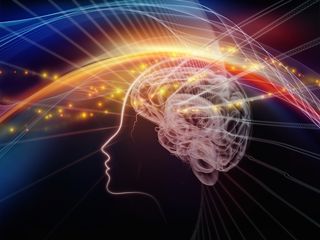
President Barack Obama has reaffirmed his vision to send humans to Mars . In an editorial posted on CNN.com today (Oct. 11), the president wrote of his goal of "sending humans to Mars by the 2030s and returning them safely to Earth, with the ultimate ambition to one day remain there for an extended time."
NASA Administrator Charles Bolden echoed the president's enthusiasm, describing in a blog post today co-written with John Holdren, a senior adviser to the president, how NASA plans to "utilize public-private partnerships to enable humans to live and work in space in a sustainable way."
Key to the ambitious endeavor, however, is ensuring the astronauts' safety, which may be difficult, according to a NASA-funded study published yesterday (Oct. 10) in the journal Scientific Reports.
The new study, in rodents, shows that astronauts could suffer from a phenomenon called "space brain" during the long trip to Mars , as cosmic radiation bombards their bodies and damages their brain cells.
Researchers exposed the laboratory-bound rodents to a level of radiation similar to that expected on a six-month one-way trip to Mars. They found that the radiation caused significant long-term brain damage, including cognitive impairments and dementia, a result of brain inflammation and damage to the rodents' neurons. [ 10 Things You Didn't Know About the Brain ]
The researchers said the new study revealed a far greater extent of brain damage than what was hinted at in their shorter, six-week study, conducted last year.
"This is not positive news for astronauts deployed on a two- to three-year round-trip to Mars," said Charles Limoli, a professor of radiation oncology at the University of California, Irvine School of Medicine, who led the study.
Sign up for the Live Science daily newsletter now
Get the world’s most fascinating discoveries delivered straight to your inbox.
NASA told Live Science that the agency is funding such studies to better understand the risks posed to its astronauts, although the agency was not aware that Limoli's study was published and could not comment on the details.
Radiation hazards
Astronauts in space face two kinds of radiation hazards. One is the solar radiation from the sun, including ultraviolet rays , X-rays, protons and electrons. The other is cosmic radiation, which emanates from all directions in deep space and comprises atomic particles far more energetic (and thus more damaging) than solar radiation.
Limoli's research was aimed at assessing the possible human health problems that could be caused by cosmic radiation on a prolonged space journey. There are almost no studies so far that have looked at this, Limoli said. Humans have lived on the International Space Station (ISS) for months at a time. Russian cosmonaut Valeri Polyakov (born Valeri Ivanovich Korshunov but later changed his name) holds the record for the longest, continuous time in orbit — almost 438 days aboard the Mir space station.
However, because Mir (which is no longer in use) and the ISS are relatively close to Earth, Earth's magnetosphere — a natural magnetic field that deflects charged atomic particles from the sun and deeper space — mostly protects astronauts on board the orbiting labs from dangerous radiation exposure. Tests have shown that Polyakov and other astronauts have no serious brain damage as a result of their time in orbit. [ 5 Mars Myths and Misconceptions ]
Astronauts who visited the moon ventured beyond this protective magnetosphere, but their entire round-trip lasted only about two weeks, so their radiation exposure was kept to a minimum. One previous study , done in 2013 in mice, suggested that radiation may hasten the development of Alzheimer's.
To simulate the cosmic radiation exposure humans would face during a long Mars trip, Limoli's group exposed rodents to charged particles at the NASA Space Radiation Laboratory at the Brookhaven National Laboratory in Upton, New York.
The researchers found that although the bombardment of the radiation was painless, it caused significant brain damage in the rodents. Imaging revealed that the animals' brain cells had a sharp reduction in features of the cells called the dendrites and spines, which would disrupt the transmission of signals among neurons , they said.
Limoli told Live Science that loss of dendrites and spines were "like a tree losing its leaves and branches," compromising the health of the tree. These physical losses explained the deficiencies the rodents showed in behavioral tasks designed to test learning and memory , Limoli said. In humans, this loss could lead astronauts to make poor decisions that could affect the safety of the crew, he added.
The researchers also discovered that the radiation affected the part of the brain that normally suppresses prior unpleasant and stressful associations, as part of a process called "fear extinction." This loss of fear extinction could make the astronauts prone to anxiety, Limoli said. [ Infographic: How Radiation Affects the Human Body ]
Yet Limoli remains optimistic that NASA can still send astronauts safely to Mars. "This is not a deal breaker," he told Live Science. "This [cosmic radiation] is simply something we have to deal with."
A 30-month trip
NASA estimates that a 30-month trip to Mars — six months of travel each way, plus 18 months living on the Red Planet — would expose astronauts to a total of 1 sievert (Sv) of radiation. For comparison, Limoli said people who undergo certain kinds of radiation treatment for brain cancer may need to endure a dose at least 10 times higher than that through the course of that treatment. He said that these cancer patients, although they may be cured of cancer, have notable declines in their cognitive function.
Astronauts could be protected from cosmic radiation in two ways, a NASA press officer told Live Science. One would be to a passive method of installing thick metal shields or layers with water, either around the entire spacecraft or around sleeping chambers to block the radiation. Cosmic radiation is very penetrating, however, and shields that would be thick enough to block the rays would add considerable weight (and thus, expense) to the Mars mission .
Another way is an active method of installing an electromagnetic field to deflect the radiation, analogous to the magnetosphere itself. Limoli said his group and others are working on another strategy, medicines that could repair the damage caused by radiation, or protect or even restore neurons.
It will certainly be a memorable trip to Mars, and NASA hopes the astronauts will stay healthy enough to remember it.
Follow Christopher Wanjek @wanjek for daily tweets on health and science with a humorous edge. Wanjek is the author of "Food at Work" and "Bad Medicine." His column, Bad Medicine , appears regularly on Live Science.

Christopher Wanjek is a Live Science contributor and a health and science writer. He is the author of three science books: Spacefarers (2020), Food at Work (2005) and Bad Medicine (2003). His "Food at Work" book and project, concerning workers' health, safety and productivity, was commissioned by the U.N.'s International Labor Organization. For Live Science, Christopher covers public health, nutrition and biology, and he has written extensively for The Washington Post and Sky & Telescope among others, as well as for the NASA Goddard Space Flight Center, where he was a senior writer. Christopher holds a Master of Health degree from Harvard School of Public Health and a degree in journalism from Temple University.
Optical illusion reveals key brain rule that governs consciousness
Super-detailed map of brain cells that keep us awake could improve our understanding of consciousness
Tiny, transparent chip could transform your smartphone into a professional-grade camera
Most Popular
- 2 James Webb telescope confirms there is something seriously wrong with our understanding of the universe
- 3 6G speeds hit 100 Gbps in new test — 500 times faster than average 5G cellphones
- 4 DARPA's autonomous 'Manta Ray' drone can glide through ocean depths undetected
- 5 2 plants randomly mated up to 1 million years ago to give rise to one of the world's most popular drinks
- 2 Deepest blue hole in the world discovered, with hidden caves and tunnels believed to be inside
- 3 Hundreds of black 'spiders' spotted in mysterious 'Inca City' on Mars in new satellite photos
- 4 2 plants randomly mated up to 1 million years ago to give rise to one of the world's most popular drinks
- 5 Stunning image shows atoms transforming into quantum waves — just as Schrödinger predicted
- GTA 5 Cheats
- Print on a Chromebook
- Nothing Phone 2 Review
- Best YouTube TV Alternatives
- Asus ROG Ally vs. Steam Deck
- Gameshare on Nintendo Switch
- Emerging Tech
It seems that going all the way to Mars may cause brain damage
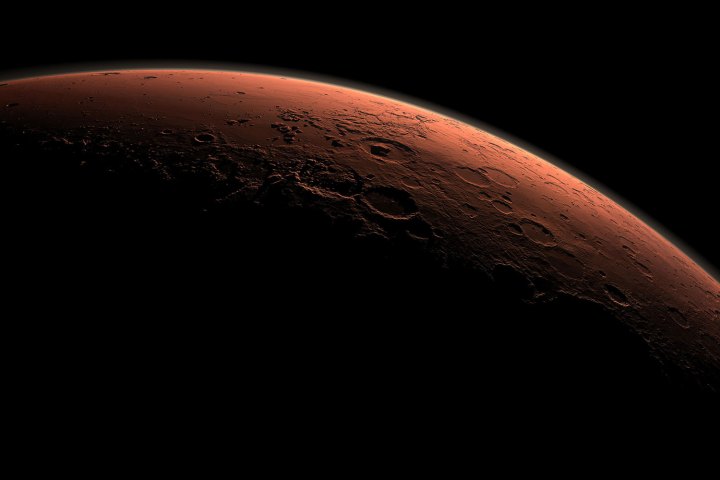
No, it doesn’t sound like a particularly sturdy foundation for the challenging task of building a new world on a faraway planet, but until someone works out how to protect space travelers from the damaging effects of prolonged cosmic ray exposure, such a scenario appears inevitable.
Research published this week by scientists at the University of California, Irvine (UCI) found that rodents exposed to highly energetic charged particles – like those found in the galactic cosmic rays that would bombard space explorers during a mission to Mars – leads to serious long-term brain damage involving “cognitive impairments and dementia.”
- Moon, Mars, and more: NASA extends 8 planetary missions
- Rocket heading for moon impact may not be SpaceX’s after all
- NASA’s Ingenuity helicopter travels 160 meters in 8th Mars flight
Putting it mildly, Professor Charles Limoli of the UCI’s School of Medicine described his team’s findings as “not positive news” for astronauts going on a two-to-three-year round trip to Mars.
He added, “The space environment poses unique hazards to astronauts. Exposure to these particles can lead to a range of potential central nervous system complications that can occur during and persist long after actual space travel – such as various performance decrements, memory deficits, anxiety, depression and impaired decision-making. Many of these adverse consequences to cognition may continue and progress throughout life.”
The tests, which were carried out at the NASA Space Radiation Laboratory at New York’s Brookhaven National Laboratory, found that parts of the brain tasked with learning and memory functions remained impaired six months after the rodents were exposed to the particles.
Interestingly, the team also found that the radiation adversely affected what’s known as “fear extinction.” This particular brain process allows you to overcome a traumatic event, allowing you, for example, to confidently return to water after a near-drowning experience.
“Deficits in fear extinction could make you prone to anxiety, which could become problematic over the course of a three-year trip to and from Mars,” Limoli said.
In a bid to make life easier for humans going on deep-space missions, scientists are currently exploring ways to increase shielding on spacecraft. However, the professor admitted that cosmic rays would still be able to penetrate solid objects to some extent and so astronauts would be unlikely to completely escape their effects. An additional strategy is looking at drug-based solutions that destroy harmful free radicals and protect neurotransmission.
NASA, too, has been studying the effects on the human body of prolonged periods in space. Last year it said that astronauts who spend six months on the International Space Station “had a more difficult time completing mental tasks and with physical coordination.”
Elon Musk wants to launch a human mission to the red planet in the next 10 years, while NASA is looking toward the 2030s or 2040s for its own manned mission. Whoever gets there first – and it might not even be either of these two players – some serious progress will need to be made to protect the travelers’ brains from those nasty cosmic rays, though it’s a challenge many plenty of scientists are no doubt happy to take on.
Editors' Recommendations
- SpaceX Crew-4 astronauts are on their way to the space station
- Elon Musk predicts date for first crewed landing on Mars
- Mars Ingenuity helicopter completes its most challenging flight yet
- NASA’s Mars helicopter wins prestigious space exploration award
- The sound of science: Why audio is the next frontier in Mars exploration

Perseverance Mars Rover’s Mastcam-Z View of 'Van Zyl Overlook' (360 video + audio)
You can feel what it would be like to stand on Mars with this 360-degree panorama of the Martian surface, captured by the NASA Perseverance rover. The interactive video includes a 2.4-billion-pixel image, made up of 992 separate images that have been combined into one, as well as audio of the sound of the Martian wind captured by the rover.
NASA’s Mars helicopter, Ingenuity, recently completed its seventh successful flight on the faraway planet.
NASA’s Jet Propulsion Laboratory (JPL) announced the news on Tuesday, June 8, though didn’t immediately say when the flight took place.
To clean a bit of dust from one of its solar panels, NASA’s InSight lander trickled sand above the panel. The wind-borne sand grains then picked up some dust on the panel, enabling the lander to gain about 30 watt-hours of energy per sol on May 22, 2021, the 884th Martian day of the mission. NASA/JPL-Caltech
It's not easy powering a robot on Mars. NASA rovers like Curiosity and Perseverance use a nuclear power system, but other explorers like the InSight lander rely on solar power. The good news is that the sun provides a constant source of energy. The bad news is that Mars is a very dusty place, and dust eventually covers solar panels and stops them from working. That's what happened to the now-defunct Opportunity rover, which ran out of power when a dust storm rolled in and prevented it from charging via its solar panels.

IMAGES
COMMENTS
Mice data suggest that astronauts could suffer brain damage on the long trip to and from Mars. After being exposed to radiation, parts of nerve cells (green) in the brains of mice were shorter (right digital image) — and branched less — than in unexposed mice (left). Particles zipping through space could be the wrong stuff for Mars astronauts.
Astronauts who travel to Mars or other destinations in deep space will leave Earth's protective cocoon for months or years at a time. And a new NASA-funded study suggests that chronic exposure ...
A Trip to Mars Could Give You Brain Damage. Exposure to cosmic rays may cause defects that would make astronauts lose their curiosity during a mission
NASA hopes to send the first round-trip, manned spaceflight to Mars by the 2030s. If the mission succeeds, astronauts could spend several years potentially being bombarded with cosmic rays—high-energy particles launched across space by supernovae and other galactic explosions. Now, a study in mice suggests that these particles could alter the shape of neurons, impairing astronauts' memories ...
Of the 30 astronauts in the study, eight had been to space for two weeks, 18 went on six-month missions, and four travelled for a year. After two weeks, the brain had not noticeable changed, and ...
Long-term exposure to deep-space radiation can damage astronauts' brains, a new study suggests. The results should inform NASA's plans for crewed missions to Mars. (Image credit: M.M. Acharya et ...
Key to the ambitious endeavor, however, is ensuring the astronauts' safety, which may be difficult, according to a NASA-funded study published yesterday (Oct. 10) in the journal Scientific Reports. The new study, in rodents, shows that astronauts could suffer from a phenomenon called "space brain" during the long trip to Mars, as cosmic radiation bombards their bodies and damages their brain ...
During a long-haul mission to Mars, astronauts would surely encounter these sorts of particles, Limoli says. This study suggests that these encounters could damage astronauts' brains, perhaps in ...
New research shows the long trip to Mars could leave astronauts and colonists diminished or even brain damaged by the time they arrive on the planet, which other scientists remind us is hostile to ...
Spaceflight can even adversely alter the anatomy of astronauts' brains. Structural brain changes have been observed in astronauts after returning from the International Space Station (ISS).
The findings suggest that space radiation could cause astronauts to suffer from memory problems, anxiety, and impaired judgment. "This is not a deal-breaker," says coauthor Charles Limoli, a ...
Now researchers have evidence to suggest that even six months after returning from an extended spaceflight, astronauts could still be experiencing significant levels of brain inflammation and neuron damage. "This is not positive news for astronauts deployed on a two-to-three-year round trip to Mars ," said one of the team, Charles Limoli, a ...
As efforts to get to Mars become more advanced, a team of researchers at the University of California at Irvine say journeying to the Red Planet could have hazardous effects on astronauts' brains.
Oct 11, 2016. Studies have found that mice suffer brain damage after being exposed to equivalent doses of cosmic radiation an astronaut would be exposed to during deep space travel. Getty Images ...
Radiation exposure from a Mars missions could cook brain cells, causing chronic dementia and memory loss, and leaving astronauts with debilitating anxiety levels, the study has found. This could ...
Mars Travelers Could Suffer Radiation Brain Damage. Mice exposed to radiation akin to what astronauts to Mars would receive experienced cognitive impairment. Lee Billings reports. Outer space may ...
Astronauts making a years-long voyage to Mars may get bombarded with enough cosmic radiation to seriously damage their brains, researchers reported Monday. The damage might be bad enough to affect ...
A new study shows that astronauts who spend over 6 months in space suffer brain swelling—and it can take as long as 3 years on Earth to recover.
NASA estimates that a 30-month trip to Mars — six months of travel each way, plus 18 months living on the Red Planet — would expose astronauts to a total of 1 sievert (Sv) of radiation. For ...
Putting it mildly, Professor Charles Limoli of the UCI's School of Medicine described his team's findings as "not positive news" for astronauts going on a two-to-three-year round trip to Mars.